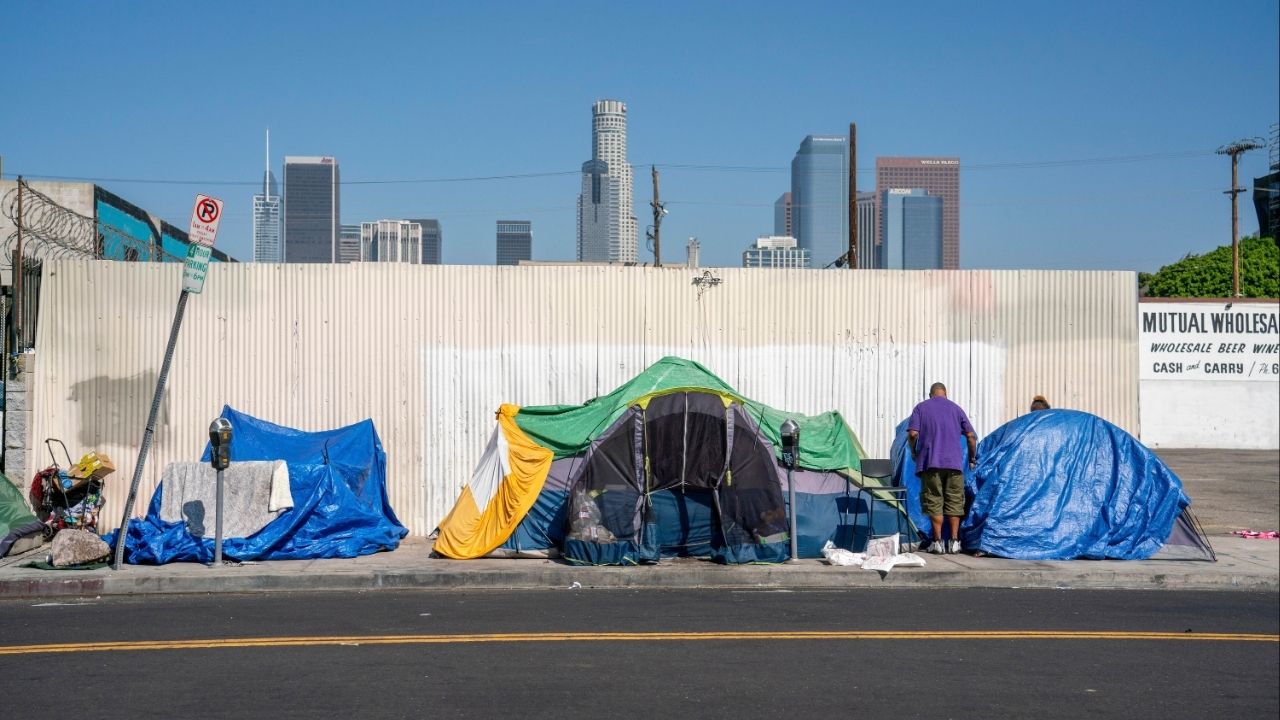A homeless encampment in the Skid Row district of Los Angeles, July 30, 2024. The Trump administration has developed plans for a wholesale shift in homelessness policy that would slash support for long-term housing programs, according to a confidential grant-making plan, and critics say it could quickly place as many as 170,000 formerly homeless people at risk of returning to the streets.(Kyle Grillot/The New York Times)

- The Trump administration plans to cut long-term housing aid by two-thirds, risking homelessness for 170,000 formerly unhoused people.
- The $3.5 billion proposal would shift funding toward short-term programs enforcing work, treatment, and encampment crackdowns.
- Critics warn the shift abandons “Housing First,” while supporters say it targets root causes like addiction and mental illness.
Share
|
Getting your Trinity Audio player ready...
|
WASHINGTON — The Trump administration has developed plans for a wholesale shift in homelessness policy that would slash support for long-term housing programs, according to a confidential grant-making plan, and critics say it could quickly place as many as 170,000 formerly homeless people at risk of returning to the streets.
Pivoting from housing aid, the administration’s approach would shift billions to short-term programs that impose work rules, help the police dismantle encampments, and require the homeless to accept treatment for mental health or addiction.
The expected shift, which would be the most consequential in a generation, is detailed in a 100-page notice from the Department of Housing and Urban Development, slated for release in coming days, that would govern more than $3.5 billion in Continuum of Care funds, the main source of federal money for homelessness.
While President Donald Trump has long pledged to pursue tougher homelessness policies, such as camping bans and treatment mandates, the long-anticipated document, reviewed by The New York Times, outlines changes that would go much deeper and faster than expected.
By cutting aid for permanent housing by two-thirds next year, the plan risks a sudden end of support for most of the people the Continuum places in such housing nationwide, beginning as soon as January. All are disabled — a condition of the aid — and many are 50 or older. The document does not explain how they would find housing.
“There are people who have been living in those units for five years, eight years,” said Ann Oliva, the chief executive of the National Alliance to End Homelessness, an advocacy group. “No one can wrap their head around the idea that HUD is about to kick 170,000 vulnerable people out of their homes. People don’t know what’s about to hit them.”
Critics Tried to Delay
With large cuts in housing aid rumored for months, critics of the administration’s approach waged an unsuccessful effort to diminish or delay them.
“HUD has not made any announcements regarding this program,” the department said in an emailed statement. “Broadly speaking, HUD will continue to serve the American people through means-tested measures to encourage self-sufficiency.”
The grant-making criteria will become official when posted on grants.gov, a federal website.
Devon Kurtz, an analyst with the conservative Cicero Institute, a Texas think tank that advises the Trump administration, disputed the idea that the funding shift would lead to mass displacement of formerly homeless people. Existing programs could preserve their funding by adapting to the new rules, he said — adding work requirements, for instance, or treatment mandates.
“Nobody in this administration wants 170,000 people turned out on the street — I can guarantee you,” he said. “But we have to raise the bar on these service providers. This alarmism is only going to scare the hell out of homeless people.”
With homelessness at a high and many people uneasy with public encampments, the funding shift marks the latest in a series of moves by Trump to seize control of an issue that he often uses to paint his Democratic opponents as weak and permissive.
In a sharply worded campaign video in 2023, he characterized the unsheltered homeless as “dangerously deranged” people destroying urban life, and he pledged to move them from city centers into treatment camps — an idea that Utah is now pursuing.
In an executive order issued in July, he demanded increased camping bans and criticized programs that prioritize housing over sobriety mandates or involuntary treatment for mental illness. The grant-making notice would implement that vision by directing federal dollars toward the president’s demands.
It gives priority to programs that require services such as substance abuse treatment, impose work rules and “cooperate and assist” in the enforcement of camping bans. It also steers funding to areas that pass and enforce those bans.
In limiting spending on long-term housing to just 30% of the $3.5 billion in aid — from about 90% this year — the Trump plan would deal a crippling blow to a movement called Housing First, which once enjoyed bipartisan support and has guided federal grant making since at least 2009. Housing First programs provide subsidized apartments without preconditions to the homeless with disabilities — offering, but not requiring, treatment for mental health or addiction.
Supporters say that the programs save lives by getting troubled people off the street, and that the housing stability prepares them to address other issues. But the housing is expensive and hard to build amid local resistance, leaving many people waiting on the street. Critics say that free housing provides an incentive for irresponsible behavior.
The treatment-first approach, embodied by Trump’s plan, pledges swifter action to address what it calls the “root causes” of homelessness, such as drug abuse and mental illness. But it risks consigning to worse destitution and danger those who cannot or do not comply. It also does not address another root cause of homelessness, soaring housing costs.
Vivian Wan, the chief executive of Abode Services in Fremont, California, which provides permanent housing to about 1,500 formerly homeless people, said programs could not simply adopt new rules.
In cutting funds for permanent housing by about two-thirds, she noted, the administration would channel remaining money to programs that under federal law can serve people for no more than two years.
That shift to temporary aid is “essentially saying that people really don’t need housing aid — they should be self-sufficient in two years,” she said. “There’s nothing I can do to tweak the program model to get people to afford rent when rent is so high.”
She called the cuts in long-term subsidies “catastrophic” for tenants and landlords alike, and said local governments and charities could not make up the aid.
Buried in the technical language are other requirements that alter the balance of power between the federal government and the 400 or so local grant-making groups, called Continuums of Care, that pass along the money to roughly 8,000 projects.
In the past, each local grant-making group was all but guaranteed to retain about 90% of its previous year’s funding, in order to ensure local stability. Most of that money went to renew existing programs, typically for permanent housing.
The new rules would reduce that protected sum, known as Tier 1 funding, to 30% of the previous year’s grant. That would shift large sums of homelessness aid into a nationally competitive pool, over which the administration would have greater sway. If it wants to move money, say, from a blue state like California to a red state like Utah, the new rules would make that easier to do.
—
This article originally appeared in The New York Times.
By Jason DeParle/Kyle Grillot
c. 2025 The New York Times Company
RELATED TOPICS:
Categories

US Dollar Dips as Government Reopens After Record Shutdown

3 Charged With Stuffed Animal Heist at Amusement Park Seen in ‘Big’

Few US Employees Find Purpose in Their Work: Gallup Poll

Trump Administration to Drastically Cut Housing Grants

Canadian Travel to the US Declines for 10th Straight Month















